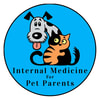What is the gastrointestinal system?
The gastrointestinal (GI) tract is the system that brings nutrients into the body. Food starts in the mouth, into the stomach, the intestines, and the waste products leave the body in feces.
The process seems fairly simple, but it is actually quite complex and the GI is a vital part of the body.
The process seems fairly simple, but it is actually quite complex and the GI is a vital part of the body.
The organs of the GI
From first bite to heading to the bathroom
When a pet starts eating their food, their salivary glands are activated releasing saliva. This saliva helps coat the food bolus before it is swallowed and has an enzyme in it called amylase that helps to start breaking down starches.
After the food bolus is swallowed it passes the pharynx in the throat and enters the esophagus. The esophagus is a muscular tube the food enters and travels through the thoracic cavity down into the stomach. There is a sphincter muscle at the bottom of the esophagus that allows the food to go into the stomach and helps to keep digestive juices from coming back up into the esophagus.
Once the food enters the stomach the digestive juices mix with the food forming a liquid suspension called chyme. This is where proteins are broken down.
The chyme is then passed through another sphincter and into the duodenum, or the first part of the small intestines.
Here the chyme receives bile from the gall bladder, and more amylase as well as lipase and trypsin from the pancreas.
What do these enzymes do?
The chyme mixture forms a bolus and is mixed with peristaltic waves. Peristaltic waves are created by the muscular layer of the intestines and help the food bolus mix together and moves it down the tract to the next sections of the intestines. The different sections of the intestines absorb different nutrients from the bolus until eventually there is nothing left to absorb and it is ready to be expelled as feces.
Where do the different nutrients get absorbed?
After the food bolus is swallowed it passes the pharynx in the throat and enters the esophagus. The esophagus is a muscular tube the food enters and travels through the thoracic cavity down into the stomach. There is a sphincter muscle at the bottom of the esophagus that allows the food to go into the stomach and helps to keep digestive juices from coming back up into the esophagus.
Once the food enters the stomach the digestive juices mix with the food forming a liquid suspension called chyme. This is where proteins are broken down.
The chyme is then passed through another sphincter and into the duodenum, or the first part of the small intestines.
Here the chyme receives bile from the gall bladder, and more amylase as well as lipase and trypsin from the pancreas.
What do these enzymes do?
- Bile helps to break down fats.
- Amylase breaks down starch.
- Lipase breaks down fatty acids.
- Trypsin breaks down proteins.
The chyme mixture forms a bolus and is mixed with peristaltic waves. Peristaltic waves are created by the muscular layer of the intestines and help the food bolus mix together and moves it down the tract to the next sections of the intestines. The different sections of the intestines absorb different nutrients from the bolus until eventually there is nothing left to absorb and it is ready to be expelled as feces.
Where do the different nutrients get absorbed?
- Duodenum: absorbs carbohydrates, fats, and amino acids
- Jejunum: absorbs carbohydrates, fats, and amino acids
- Ileum: absorbs bile salts, vitamin B12, and electrolytes
- Colon: water, electrolytes, vitamins
The video below is a great overview of the digestive tract. Even though it is focused on humans, it still applies to dogs and cats since we're all mammals.
Pages Related to the Gastrointestinal System
Liver
For more information about the liver, visit the liver page here.
Resources:
Petfoodology from Cummings Veterinary Medical Center at Tufts University:
The clinical nutrition service at Tufts University has a wonderful blog all related to veterinary nutrition, click here to check the Petfoodology blog.
Books:
- The Digestive System. UC Berkeley.edu. Retrieved on 3-20-19 from https://mcb.berkeley.edu/courses/mcb32/Miller%20notes-%20digestive%20system%20
- Small Animal Internal Medicine For Veterinary Technicians. Merrill, L.

Ready to Work Together?
Join our community and learn how to live a happier, healthier life with your fur babies.
Thank you!
You have successfully joined our subscriber list.
Last updated March 2019

